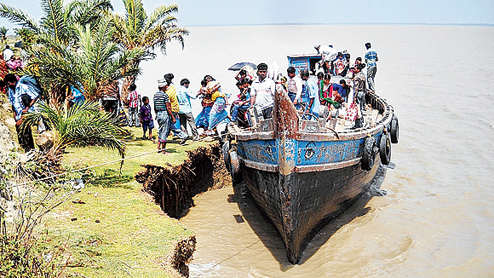Last year, around this time, in the aftermath of Cyclone Amphan, I had written in this column that crises bring us to crossroads where the choice is between doing things that were not considered earlier or were thought to be impossible, and trying to get back to the ‘before’. Every attempt to try and get back to the state we were in ‘before’ is a waste of the opportunities presented by a serious crisis.
The Telegraph on June 11 reported an attempt to do something different in the aftermath of Cyclone Yaas, supposedly a first. It seems that the state government of West Bengal has set in motion a process of rehabilitating hundreds of families that are perennially exposed to the vagaries of nature, starting with 35 families of Ghoramara island. State-facilitated movement away from Ghoramara on earlier occasions have not necessarily resulted in positive outcomes.
What is the aim of these relocation attempts? Bare existence in a somewhat less vulnerable location? Can the serious crisis not be used as an opportunity to move people from bare existence to a wholesome life where one lives up to one’s potential and prosperity?
For over a decade, my colleagues and I have been advocating an induced but organic movement of people out of harm’s way. The idea may be gaining currency but often it has been misinterpreted as being akin to development/conservation-induced resettlement, leading to irreconcilable loss of an entire lifeworld of the resettled. While moving people away from a particular ecology, landscape and set of livelihoods does bring about a loss of relating to and inhabiting a landscape, as well as the loss of old and new skills, knowledge systems, socio-cultural and religious cosmologies, this sense of loss can be made bearable or even eliminated depending upon how the movement of people out of harm’s way is induced.
Moving away under duress and against one’s wishes causes an acute sense of loss, and communities and households under such circumstances are worse off. One only needs to speak to adult victims of the Partition to ascertain the sense of loss and the poorer outcomes of such displacement. However, moving out of harm’s way can be positive provided the movement is not abrupt and those who need to move are in a position to monetize their assets, decide when they want to move, and where they want to go.
Moving the vulnerable from Ghoramara to Sagar can address the vulnerability to cyclones minimally given the vastness of low pressure weather systems and the proximity of the two islands. This resettlement can only help the people to barely exist. The people of the Sunderbans deserve more than rehabilitation, and the state can and should do better under the current dispensation with a renewed mandate. Rehabilitation, at most, will restore them to the ‘before’ state which is not something to aspire to. What could be the reason for preferring status quo over substantial improvement and prosperity? Maintaining status quo in the Sunderbans is not necessarily the cheaper option; just to upgrade the embankment and provide basic permanent housing would cost 2.25 times of the local GDP. This, however, would not address the many other long-standing risks and hazards that the residents of the Sunderbans face. These risks and hazards emanate from tidal asymmetry and interrupted sediment dispersal mechanisms.
Pre-monsoon Bay of Bengal cyclones are intensifying because of enhanced large-scale monsoon circulation associated with local atmospheric warming; climate models project continued warming. Since the Bay of Bengal is landlocked with densely populated coastlines, tropical cyclones here are among the most destructive. The north Indian Ocean, including the Arabian Sea and the Bay of Bengal, accounts for about 6 per cent of the global tropical cyclones. Cyclone frequency in this region varies between one and three in the pre-monsoon (March-May) period, and between two and five in the post-monsoon (October-December) season. It is unsurprising that the Sunderbans or parts of it were affected in May 2020 and again in May 2021. During the previous decade, the cyclones, Sidr and Aila, struck the region in a span of 19 months.
Owing to the lay of the land, premature land reclamation and persistence with the colonial policy blunder since Independence, the agrarian economy of the region, and the general lack of development, the impact of hydrometeorological events are severe in terms of loss of livelihoods and assets. Human suffering in the absence of large-scale interventions as in New Orleans and the Netherlands will recur since large-scale interventions in the region are unlikely in view of the Unesco world heritage sites.
The people of Ghoramara and elsewhere in the Indian Sunderbans need to be able to exercise the choice of where they want to go and when they want to go, if they want to go. How such choice could be exercised will need another column.











